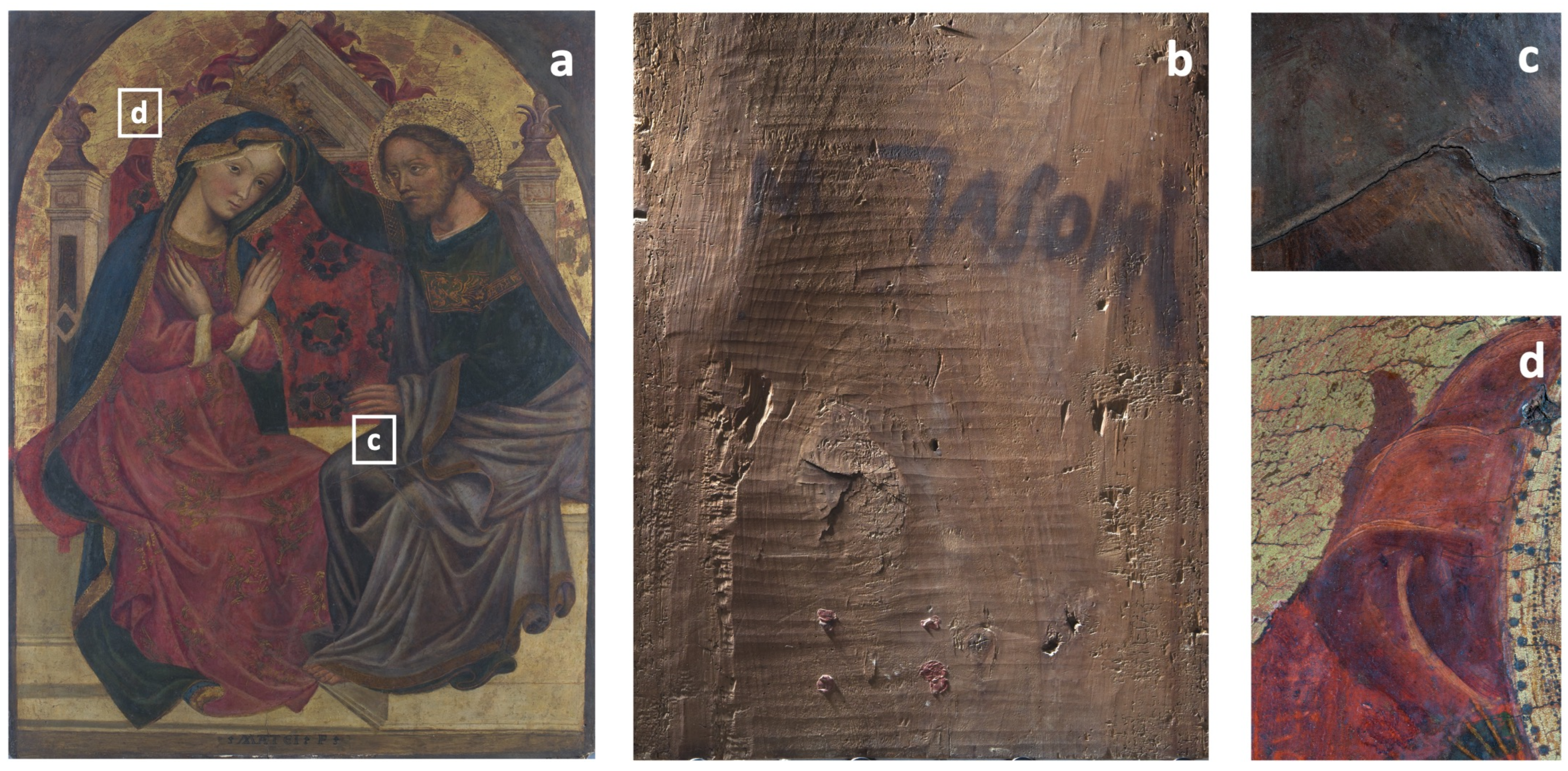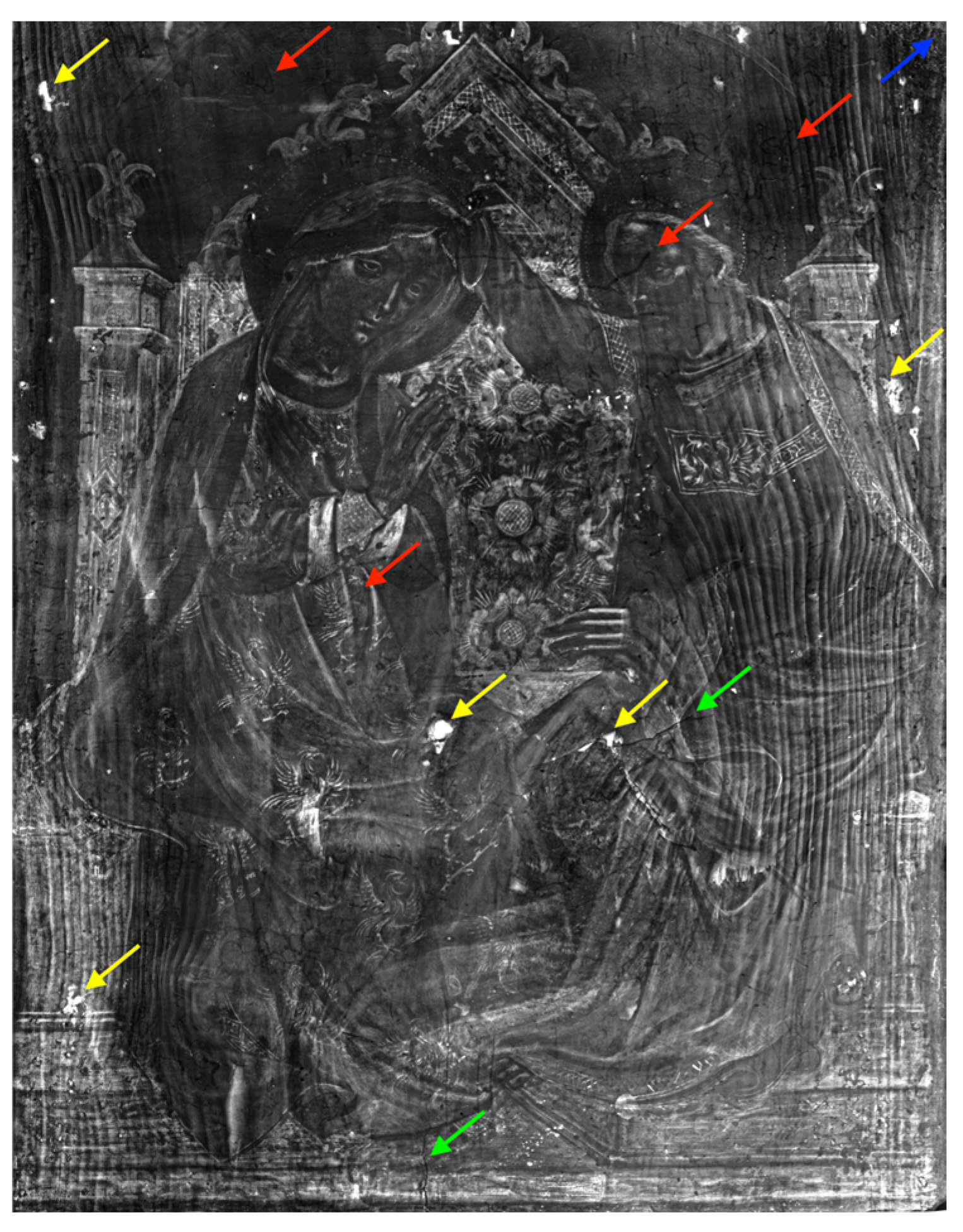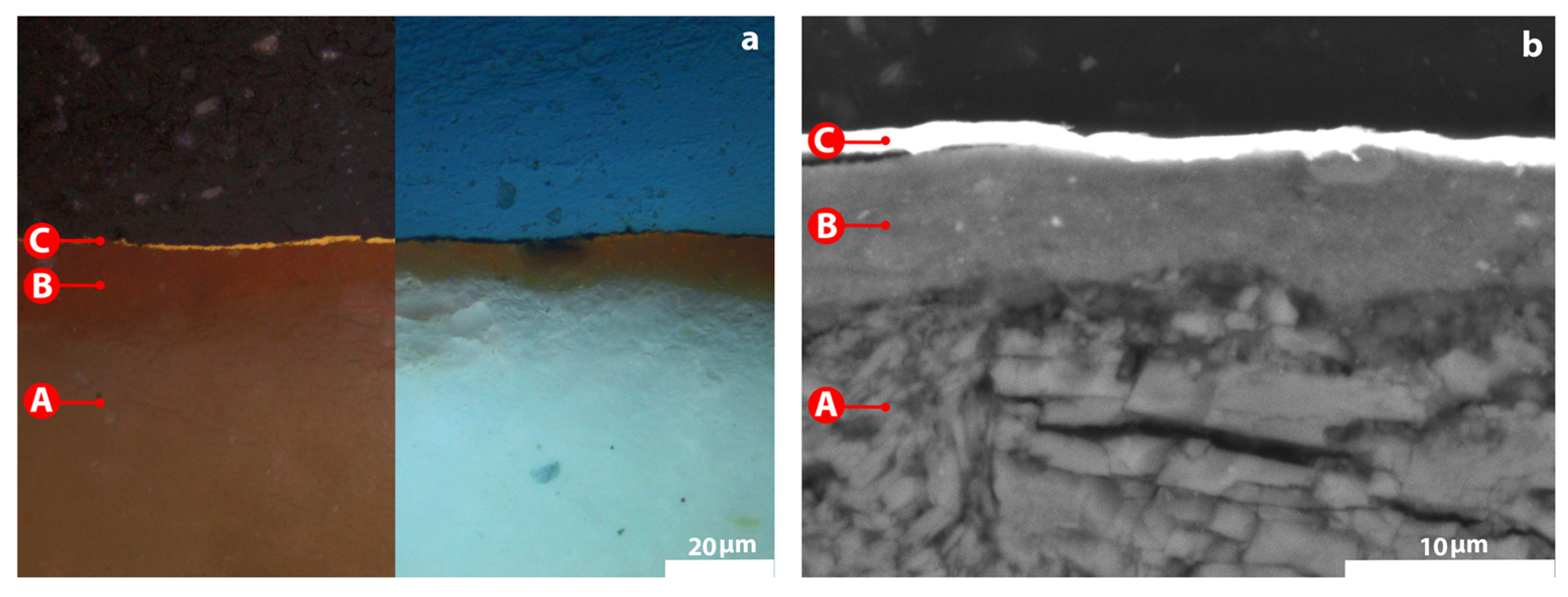Rediscovering the Painting Technique of the 15th Century Panel Painting Depicting the Coronation of the Virgin by Michele di Matteo
Abstract
1. Introduction
2. Experimental Section
3. Results and Discussion
3.1. Preliminary Observations by Imaging Techniques
3.2. Non-Invasive Characterization of Painting Materials
3.2.1. Blue Pigments
3.2.2. Green and Blue Pigments
3.2.3. White Pigments
3.2.4. Red Pigments
3.2.5. Flesh Tone Pigments
3.2.6. The Painting Technique: Ground Layer and Gilding
4. Conclusions
Supplementary Materials
Author Contributions
Funding
Data Availability Statement
Acknowledgments
Conflicts of Interest
References
- Šefců, R.; Chlumská, Š.; Třeštíková, A.; Trojek, T.; Dragounová, L. Investigation of the panel painting of St Anne with the Virgin Mary and the Child Jesus using analytical and imaging methods. Appl. Radiat. Isot. 2015, 95, 8–12. [Google Scholar] [CrossRef] [PubMed]
- Dal Fovo, A.; Mattana, S.; Ramat, A.; Riitano, P.; Cicchi, R.; Fontana, R. Insights into the stratigraphy and palette of a painting by Pietro Lorenzetti through non-invasive methods. J. Cult. Herit. 2023, 61, 91–99. [Google Scholar] [CrossRef]
- Klisinska-Kopacz, A.; Obarzanowski, M.; Fraczek, P.; Moskal-del Hoyo, M.; Gargano, M.; Goslar, T.; Chmielewski, F.; Dudała, J.; del Hoyo-Meléndez, M.J. An analytical investigation of a wooden panel painting attributed to the workshop of Lucas Cranach the Elder. J. Cult. Herit. 2022, 55, 185–194. [Google Scholar] [CrossRef]
- Pellerito, C.; Di Marco, A.E.; Di Natale, M.C.; Pignataro, B.; Scopelliti, M.; Sebastianelli, M. Scientific studies for the restoration of a wood painting of the Galleria Interdisciplinare Regionale della Sicilia—Palazzo Mirto. Microchem. J. 2016, 124, 682–692. [Google Scholar] [CrossRef]
- Pięta, E.; Proniewicz, E.; Szmelter-Fausek, B.; Olszewska-Świetlik, J.; Proniewicz, L.M. Pigment characterization of important golden age panel paintings of the 17th century. Spectrochim. Acta Part A Mol. Biomol. Spectrosc. 2015, 136, 594–600. [Google Scholar] [CrossRef]
- cassiciaco.it. Available online: http://www.cassiciaco.it/navigazione/iconografia/pittori/quattrocento/di_matteo/di_matteo.html (accessed on 7 July 2023).
- Bellazzecca, E. Michele di Matteo da Bologna; Dizionario Biografico degli Italiani; Istituto dell’Enciclopedia Italiana: Roma, Italia, 2010; Volume 74. [Google Scholar]
- Bolognini Amorini, A. Le Vite dei Pittori ed Artefici Bolognesi, I; Tipi Governativi alla Volpe: Bologna, Italia, 1841; p. 21. [Google Scholar]
- Filippini, F.; Zucchini, G. Miniatori e Pittori a Bologna, II, Documenti del Secolo XV; Accademia nazionale dei Lincei: Roma, Italia, 1968; pp. 122–126. [Google Scholar]
- Massaccesi, F. Nuove Riflessioni Sul Percorso di M. di M.; Arte cristiana XCVII; Scuola Beato Angelico e dell’Istituto di Storia dell’Arte dell’Università Cattolica: Milano, Italia, 2009; Volume 852, pp. 171–180. [Google Scholar]
- Gargano, M.; Bonizzoni, L.; Grifoni, E.; Melada, J.; Guglielmi, V.; Bruni, S.; Ludwig, N. Multi-analytical investigation of panel, pigments and varnish of The Martyirdom of St. Catherine by Gaudenzio Ferrari (16th century). J. Cult. Herit. 2020, 46, 289–297. [Google Scholar] [CrossRef]
- Cavaleri, T.; Pelosi, C.; Giustetto, R.; Andreotti, A.; Bonaduce, I.; Calabrò, G.; Caliri, C.; Colantonio, C.; Manchinu, P.; Legnaioli, S.; et al. The northern-Italy Renaissance in a panel by Defendente Ferrari A complete study with a multi-analytical investigation. J. Archaeol. Sci. Rep. 2022, 46, 103669. [Google Scholar] [CrossRef]
- Galli, A.; Gargano, M.; Bonizzoni, L.; Bruni, S.; Interlenghi, M.; Longoni, M.; Passaretti, A.; Caccia, M.; Salvatore, C.; Castiglioni, I.; et al. Imaging and spectroscopic data combined to disclose the painting techniques and materials in the fifteenth century Leonardo atelier in Milan. Dyes Pigment 2021, 187, 109112. [Google Scholar] [CrossRef]
- Venuti, V.; Fazzari, B.; Crupi, V.; Majolino, D.; Paladini, G.; Morabito, G.; Certo, G.; Lamberto, S.; Giacobbe, L. In situ diagnostic analysis of the XVIII century Madonna della Lettera panel painting (Messina, Italy). Spectrochim. Acta Part A Mol. Biomol. Spectrosc. 2020, 228, 117822. [Google Scholar] [CrossRef]
- Invernizzi, C.; Daveri, A.; Rovetta, T.; Vagnini, M.; Licchelli, M.; Cacciatori, F.; Malagodi, M. A multi-analytical non-invasive approach to violin materials: The case of Antonio Stradivari “Hellier” (1679). Microchem. J. 2016, 124, 743–750. [Google Scholar] [CrossRef]
- Volpi, F.; Fiocco, G.; Rovetta, T.; Invernizzi, C.; Albano, M.; Licchelli, M.; Malagodi, M. New Insights on the Stradivari “Coristo” Mandolin: A Combined Non- Invasive Spectroscopic Approach. Appl. Sci. 2021, 11, 11626. [Google Scholar] [CrossRef]
- Pięta, E.; Olszewska-Świetlik, J.; Paluszkiewicz, C.; Zając, A.; Kwiatek, W.M. Application of ATR-FTIR mapping to identification and distribution of pigments, binders and degradation products in a 17th century painting. Vib. Spectrosc. 2019, 103, 102928. [Google Scholar] [CrossRef]
- Volpi, F.; Vagnini, M.; Vivani, R.; Malagodi, M.; Fiocco, G. Non-invasive identification of red and yellow oxide and sulfide pigments in wall-paintings with portable ER-FTIR spectroscopy. J. Cult. Herit. 2023, 63, 158–168. [Google Scholar] [CrossRef]
- Rieppi, N.; Price, B.A.; Sutherland, K.; Lins, A.P.; Newman, R.; Wang, P.; Wang, T.; Tague, T.J., Jr. Salvator Mundi: An investigation of the painting’s materials and techniques. Herit. Sci. 2020, 8, 39. [Google Scholar] [CrossRef]
- Stanzani, E.; Bersania, D.; Lotticia, P.; Colomban, P. Analysis of artist’s palette on a 16th century wood panel painting by portable and laboratory Raman instruments. Vib. Spectrosc. 2016, 85, 62–70. [Google Scholar] [CrossRef]
- Van der Werf, I.D.; Gnisci, R.; Marano, D.; De Benedetto, G.E.; Laviano, R.; Pellerano, D.; Vona, F.; Pellegrin, F.; Andriani, E.; Catalano, I.M.; et al. San Francesco d’Assisi (Apulia, South Italy) Study of a manipulated 13th century panel painting by complementary diagnostic techniques. J. Cult. Herit. 2008, 9, 162–171. [Google Scholar] [CrossRef]
- Lo Monaco, A.; Mattei, E.; Pelosi, C.; Santancini, M. The scientific investigation for the study and conservation of the wooden model of S. Maria della Consolazione’s church (Todi, Italy). J. Cult. Herit. 2013, 14, 537–543. [Google Scholar] [CrossRef]
- Fiocco, G.; Volpi, F.; Rovetta, T.; Lee, C.; Albano, M.; Weththimuni, M.; Colella, M.; Magrassi Matricardi, A.L.; Merlo, C.; Malagodi, M.; et al. Analytical investigations on polychrome artworks from the wooden ceiling of “ex-Ospedale San Matteo” in Pavia. In Proceedings of the IMEKO TC4 Conference Proceeding 2023 of the Metroarchaeo 2023 conference, Rome, Italy, 19–21 October 2023. accepted for publication. [Google Scholar]
- Volpi, F.; Albano, M.; Fiocco, G.; Weththimuni, M.; Malagodi, M. Unveiling Hidden Insights of Ancient Roman wall paintings in Cremona: In-Depth Knowledge Beyond the Surface with Spectroscopic Analysis. In Proceedings of the IMEKO TC4 Conference Proceeding 2023, Pordenone, Italy, 20–21 September 2023. accepted for publication. [Google Scholar]
- Seccaroni, C.; Moioli, P.; Fluorescenza, X. Prontuario per l’Analisi XRF Portatile Applicata a Superfici Policrome; Nardini Editore: Firenze, Italia, 2004. [Google Scholar]
- Eastaugh, N.; Walsh, V.; Chaplin, T.; Siddall, R. Pigment. Compendium: A Dictionary and Optical Microscopy of Historic Pigments; Elsevier: Burlington, MA, USA, 2008. [Google Scholar]
- Bevilacqua, N.; Borgioli, L.; Gracia, I.A. I Pigmenti Nell’Arte Dalla Preistoria Alla Rivoluzione Industriale; Il Prato: Saonara, Italia, 2010. [Google Scholar]
- Doménech-Carbó, A.; Doménech-Carbó, M.T.; Osete-Cortina, L.; Donnici, M.; Guasch-Ferré, N.; Gasol-Fargas, R.M.; Iglesias-Campos, M.A. Electrochemical assessment of pigments-binding medium interactions in oil paint deterioration: A case study on indigo and Prussian blue. Herit. Sci. 2020, 8, 71. [Google Scholar] [CrossRef]
- Silva, C.E.; Silva, L.P.; Edwards, H.; De Oliveira, L. Diffuse reflection FTIR spectral database of dyes and pigments. Anal. Bioanal. Chem. 2006, 386, 2183–2191. [Google Scholar] [CrossRef]
- Nodari, L.; Ricciardi, P. Non-invasive identification of paint binders in illuminated manuscripts by ER-FTIR spectroscopy: A systematic study of the influence of different pigments on the binders’ characteristic spectral features. Herit. Sci. 2019, 7, 7. [Google Scholar] [CrossRef]
- Van Loon, A.; Noble, P.; De Man, D.; Alfeld, M.; Callewaert, T.; Van der Snickt, G.; Janssens, K.; Dik, J. The role of smalt in complex pigment mixtures in Rembrandt’s Homer 1663: Combining MA-XRF imaging, microanalysis, paint reconstructions and OCT. Herit. Sci. 2020, 8, 90. [Google Scholar] [CrossRef]
- Barilaro, D.; Crupi, V.; Interdonato, S.; Majolino, D.; Venuti, V.; Barone, G.; La Russa, M.F.; Bardelli, F. Characterization of blue decorated Renaissance pottery fragments from Caltagirone (Sicily, Italy). Appl. Phys. A Mater. Sci. Process. 2008, 92, 91–96. [Google Scholar] [CrossRef]
- Ricciardi, P.; Dooley, K.A.; MacLennan, D.; Bertolotti, G.; Gabrieli, F.; Schmidt Patterson, C.; Delaney, J.K. Use of standard analytical tools to detect small amounts of smalt in the presence of ultramarine as observed in 15th-century Venetian illuminated manuscripts. Herit. Sci. 2022, 10, 38. [Google Scholar] [CrossRef]
- Galliano Lalli, C.; Innocenti, F. Appunti Sulle Caratteristiche Chimico-Fisiche Dell’Azzurrite e Del Lapislazzuli. OPD Restauro 2014, 26, 78–82. Available online: http://www.jstor.org/stable/24398163 (accessed on 3 January 2024).
- Giménez, P.; Linares, A.; Sessa, C.; Bagán, H.; García, J.F. Capability of Far-Infrared for the selective identification of red and black pigments in paint layers. Spectrochim. Acta Part A Mol. Biomol. Spectrosc. 2022, 266, 120411. [Google Scholar] [CrossRef]
- Cennini, C. Il Libro dell’arte, a Cura di F. Frezzato; Neri Pozza Editore: Vicenza, Italia, 2016. [Google Scholar]








| Investigated Area (XRF Spot) | Colour | Pigment Attribution | Marker XRF Elements | Maker FTIR Bands | References |
|---|---|---|---|---|---|
| 8—Virgin’s mantle over her shoulder | Blue | Prussian blue, Smalt, Blue Cu-based pigment | Fe, Co, K, As, Cu, Si | 2098 cm−1, 1020 cm−1 | [4,5,14,16,17,19,22,25,27,28,29,30] |
| 9—Virgin’s mantle over her head | Blue | Prussian blue, Smalt, Blue Cu-based pigment | Fe, K, Co, Cu, Si, As | 2098 cm−1, 1020 cm−1 | [4,5,14,16,17,19,22,25,27,28,29,30] |
| 14—Virgin’s mantle | Blue | Prussian blue, Blue Cu-based pigment | Fe, Cu | - | [5,14,25,27] |
| 15—Virgin’s mantle | Blue | Prussian blue, Blue Cu-based pigment | Fe, Cu | - | [5,14,25,27] |
| 25—Christ’s mantle | Blue | Prussian blue, Blue Cu-based pigment | Fe, Cu | - | [5,14,25,27] |
| 28—Christ’s mantle | Blue | Prussian blue, Blue Cu-based pigment | Fe, Cu | - | [5,14,25,27] |
| 29—Christ’s mantle | Blue | Prussian blue, Blue Cu-based pigment | Fe, Cu | - | [5,14,25,27] |
| 21—Virgin’s dress | Dark Green/Blue | Green pigment based on copper, Prussian blue, Green earth | Cu, Fe, Si | 1020 cm−1, 2098 cm−1 | [4,11,14,25,27,28,29,30] |
| 30—Christ’s garment | Dark Green/Blue | Green pigment based on copper, Prussian blue, Green earth | Cu, Fe, Si | - | [11,14,25,27] |
| 31—Christ’s garment collar | Dark Green/Blue | Prussian blue, Green earth, Green pigment based on copper | Fe, Cu, Si | - | [11,14,25,27] |
| 32—Christ’s garment collar | Dark Green/Blue | Green pigment based on copper, Prussian blue, Green earth | Cu, Fe, Si | - | [11,14,25,27] |
| 11—Throne structure | White | Lead white, Iron-based earth | Pb, Fe | 3547 cm−1, 1450 cm−1, 678 cm−1 | [11,14,17,18,25,27,29,30,35] |
| 12—Throne structure | White | Lead white, Iron-based earth | Pb, Fe | - | [11,14,25,27] |
| 13—Throne structure | White | Lead white, Iron-based earth | Pb, Fe | - | [11,14,25,27] |
| 22—Throne structure | White | Lead white, Iron-based earth | Pb, Fe | - | [11,14,25,27] |
| 23—Throne structure | White | Lead white, Iron-based earth | Pb, Fe | - | [11,14,25,27] |
| 26—Throne structure | White | Lead white, Iron-based earth | Pb, Fe | 3547 cm−1, 1450 cm−1, 678 cm−1 | [11,14,17,18,25,27,29,30,35] |
| 27—Throne structure | White | Lead white, Iron-based earth | Pb, Fe | - | [11,14,25,27] |
| 16—Virgin’s dress sleeve | Red | Cinnabar, Red ochre | Hg, Fe | 530 cm−1, 450 cm−1, 1020 cm1, 1030 cm−1 | [4,11,14,18,25,27,29,35] |
| 17—Virgin’s dress sleeve | Red | Cinnabar, Red ochre | Hg, Fe | - | [11,14,25,27] |
| 19—Pillow | Red | Cinnabar, Red ochre | Hg, Fe | - | [11,14,25,27] |
| 20—Pillow | Red | Cinnabar, Red ochre | Hg, Fe | - | [11,14,25,27] |
| 5—Virgin’s cheek | Flesh tones | Cinnabar, Lead white, Haematite | Pb, Hg, Fe | 1090 cm−1, 1040 cm−1, 480 cm−1, 540 cm−1 | [4,11,14,18,25,27,29,35] |
| 6—Virgin’s lips | Flesh tones | Cinnabar, Lead white, Haematite/Red ochre | Pb, Hg, Fe | - | [11,14,25,27] |
| 7—Virgin’s neck | Flesh tones | Red ochre, Cinnabar | Pb, Fe, Hg | 1440 cm−1, 680 cm−1 | [11,14,17,25,27,30,35] |
Disclaimer/Publisher’s Note: The statements, opinions and data contained in all publications are solely those of the individual author(s) and contributor(s) and not of MDPI and/or the editor(s). MDPI and/or the editor(s) disclaim responsibility for any injury to people or property resulting from any ideas, methods, instructions or products referred to in the content. |
© 2024 by the authors. Licensee MDPI, Basel, Switzerland. This article is an open access article distributed under the terms and conditions of the Creative Commons Attribution (CC BY) license (https://creativecommons.org/licenses/by/4.0/).
Share and Cite
Delledonne, C.; Albano, M.; Rovetta, T.; Borghi, G.; Gentile, M.; Marvelli, A.D.; Mezzabotta, P.; Riga, L.; Salvini, E.; Trucco, M.; et al. Rediscovering the Painting Technique of the 15th Century Panel Painting Depicting the Coronation of the Virgin by Michele di Matteo. Heritage 2024, 7, 324-337. https://doi.org/10.3390/heritage7010016
Delledonne C, Albano M, Rovetta T, Borghi G, Gentile M, Marvelli AD, Mezzabotta P, Riga L, Salvini E, Trucco M, et al. Rediscovering the Painting Technique of the 15th Century Panel Painting Depicting the Coronation of the Virgin by Michele di Matteo. Heritage. 2024; 7(1):324-337. https://doi.org/10.3390/heritage7010016
Chicago/Turabian StyleDelledonne, Chiara, Michela Albano, Tommaso Rovetta, Gianmarco Borghi, Mario Gentile, Anna Denia Marvelli, Piero Mezzabotta, Lucia Riga, Elisa Salvini, Marta Trucco, and et al. 2024. "Rediscovering the Painting Technique of the 15th Century Panel Painting Depicting the Coronation of the Virgin by Michele di Matteo" Heritage 7, no. 1: 324-337. https://doi.org/10.3390/heritage7010016
APA StyleDelledonne, C., Albano, M., Rovetta, T., Borghi, G., Gentile, M., Marvelli, A. D., Mezzabotta, P., Riga, L., Salvini, E., Trucco, M., Volpi, F., & Fiocco, G. (2024). Rediscovering the Painting Technique of the 15th Century Panel Painting Depicting the Coronation of the Virgin by Michele di Matteo. Heritage, 7(1), 324-337. https://doi.org/10.3390/heritage7010016












